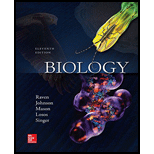
Concept explainers
Introduction:
“Biomarkers” are the chemical remains of the ancient organisms embedded in rocks. They are useful for the analysis and composition of the remains of the organisms prevent in the evolutionary history of the organism.
Answer to Problem 1U
Correct answer:
“Biomarkers” are the chemical substances found in the ancient remains of the organisms which are helpful in the analysis of the remains of the organisms in the evolutionary history. Therefore, option b. is correct.
Explanation of Solution
Reason for the correct statement:
Biomarkers help in the study of the imprint of the remains of the organisms present in the rocks. They help in the deciphering of the chemical structure and composition of the remnants of the organisms. They are present like an imprint on the rocks and are embedded inside them in a specific pattern.
Option b. is given as “A hydrocarbon found in an ancient rock layer”.
As, “biomarkers are the chemical substances present in the ancient layer of the rocks and helps in determining the structure of the ancient remains of the organisms” is the right answer.
Hence, the option b. is correct.
Reasons for the incorrect statements:
Option a. is given as “A microfossil found in a meteorite”. The meteorite consists of the rocky mineral material from the outer space world in the universe. So, it is the wrong answer.
Option c. is given as “An area that is high in carbon-12 concentration in a rock layer”. The radioactive dating of carbon-12 is done in the ancient layer of the rocks for analyzing the age of the fossil records. So, it is a wrong answer.
Option d. is given as “A newly discovered formation of stromatolites”. The stromatolites are the ancient fossil records of the cyanobacteria in the ancient rocks. So, it is a wrong answer.
Hence, options a., c., and d. are incorrect.
Biomarkers are the ancient imprint of the primitive organisms in the rock layers. They help in the deciphering of the structure and composition of the fossils.
Want to see more full solutions like this?
Chapter 28 Solutions
Biology
- Q8. A researcher wants to study the effectiveness of a pill intended to reduce stomach heartburn in pregnant women. The researcher chooses randomly 400 women to participate in this experiment for 9 months of their pregnancy period. They all need to have the same diet. The researcher designs two groups of 200 participants: One group take the real medication intended to reduce heartburn, while the other group take placebo medication. In this study what are: Independent variable: Dependent variable: Control variable: Experimental group: " Control group: If the participants do not know who is consuming the real pills and who is consuming the sugar pills. This study is It happens that 40% of the participants do not find the treatment helpful and drop out after 6 months. The researcher throws out the data from subjects that drop out. What type of bias is there in this study? If the company who makes the medication funds this research, what type of bias might exist in this research work?arrow_forwardHow do I determine the inhertiance pattern from the pedigree diagram?arrow_forwardits an open book assignemntarrow_forward
- Describe two different gene regulation mechanisms involving methylationarrow_forwardWhat is behavioral adaptarrow_forward22. Which of the following mutant proteins is expected to have a dominant negative effect when over- expressed in normal cells? a. mutant PI3-kinase that lacks the SH2 domain but retains the kinase function b. mutant Grb2 protein that cannot bind to RTK c. mutant RTK that lacks the extracellular domain d. mutant PDK that has the PH domain but lost the kinase function e. all of the abovearrow_forward
- Basic Clinical Lab Competencies for Respiratory C...NursingISBN:9781285244662Author:WhitePublisher:CengageEssentials of Pharmacology for Health ProfessionsNursingISBN:9781305441620Author:WOODROWPublisher:Cengage
 Biology (MindTap Course List)BiologyISBN:9781337392938Author:Eldra Solomon, Charles Martin, Diana W. Martin, Linda R. BergPublisher:Cengage Learning
Biology (MindTap Course List)BiologyISBN:9781337392938Author:Eldra Solomon, Charles Martin, Diana W. Martin, Linda R. BergPublisher:Cengage Learning  Comprehensive Medical Assisting: Administrative a...NursingISBN:9781305964792Author:Wilburta Q. Lindh, Carol D. Tamparo, Barbara M. Dahl, Julie Morris, Cindy CorreaPublisher:Cengage Learning
Comprehensive Medical Assisting: Administrative a...NursingISBN:9781305964792Author:Wilburta Q. Lindh, Carol D. Tamparo, Barbara M. Dahl, Julie Morris, Cindy CorreaPublisher:Cengage Learning Medical Terminology for Health Professions, Spira...Health & NutritionISBN:9781305634350Author:Ann Ehrlich, Carol L. Schroeder, Laura Ehrlich, Katrina A. SchroederPublisher:Cengage Learning
Medical Terminology for Health Professions, Spira...Health & NutritionISBN:9781305634350Author:Ann Ehrlich, Carol L. Schroeder, Laura Ehrlich, Katrina A. SchroederPublisher:Cengage Learning





